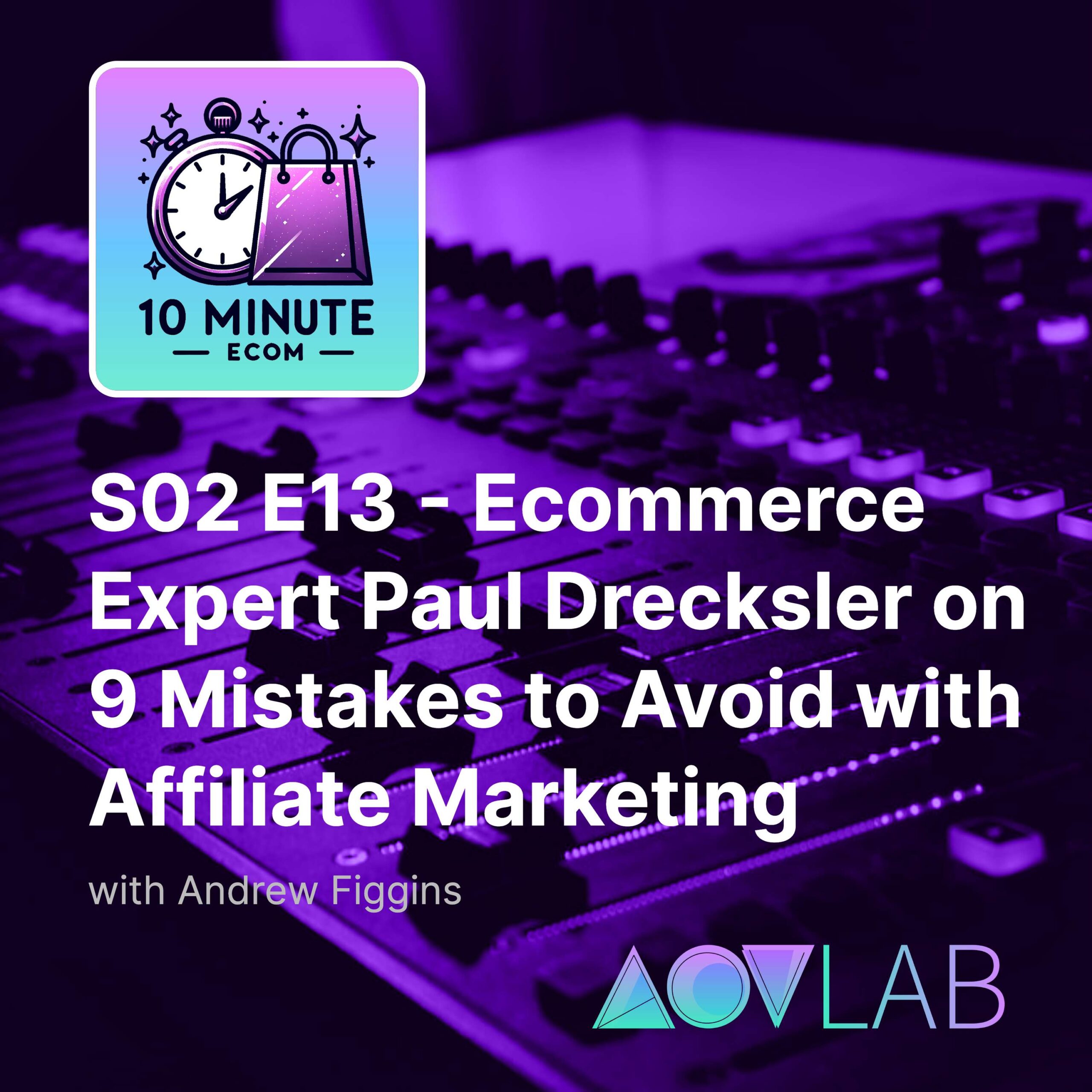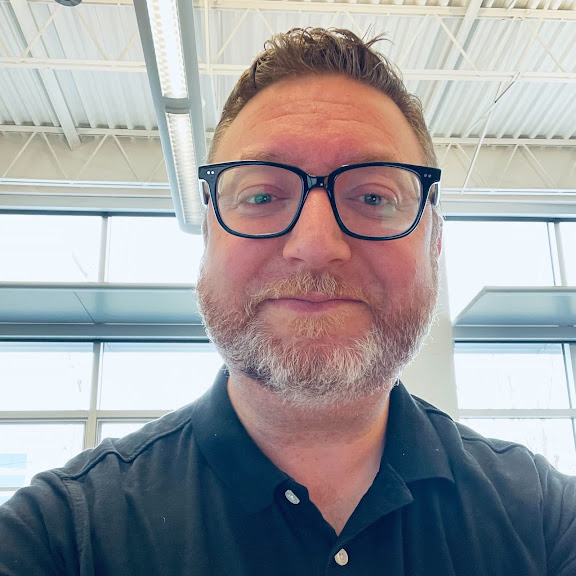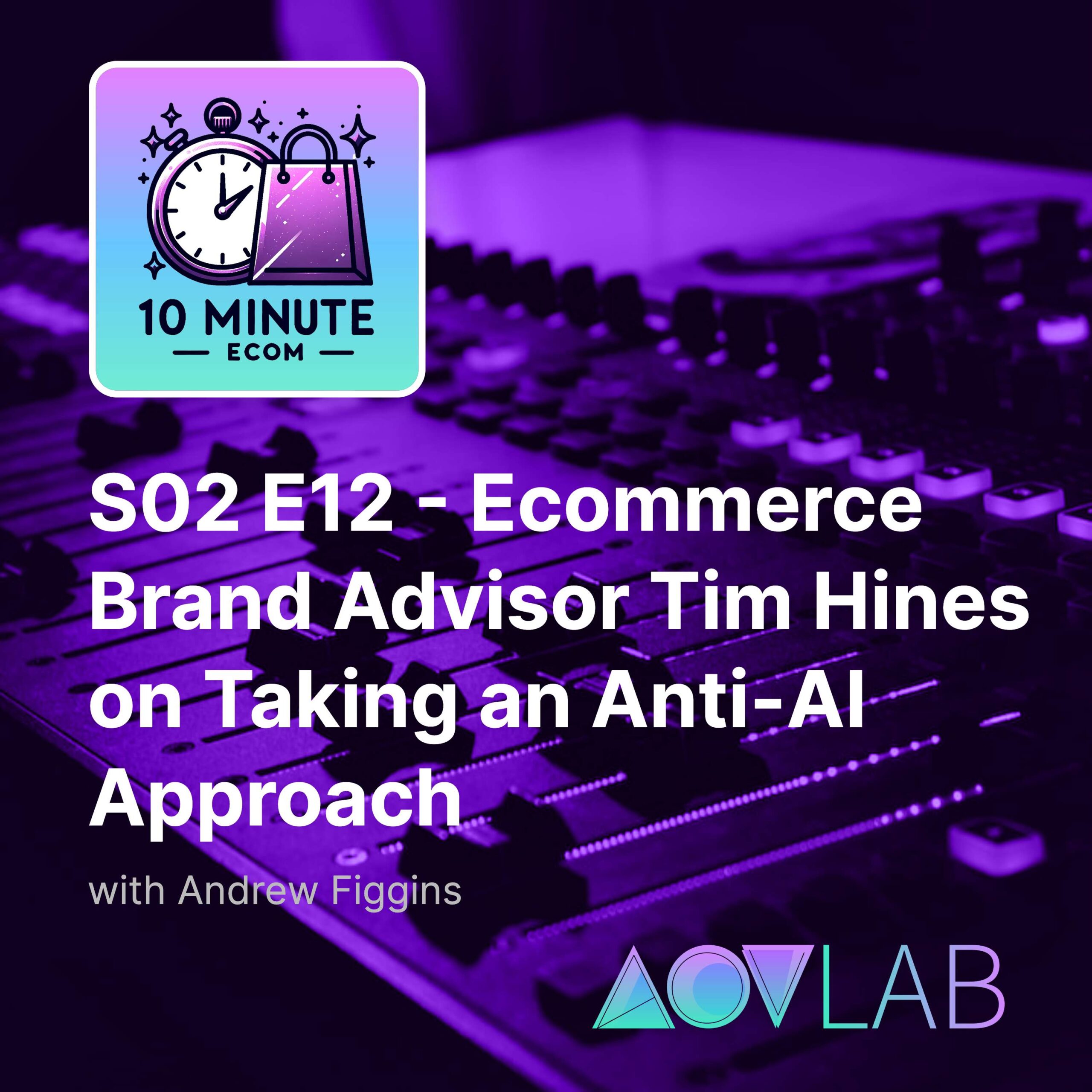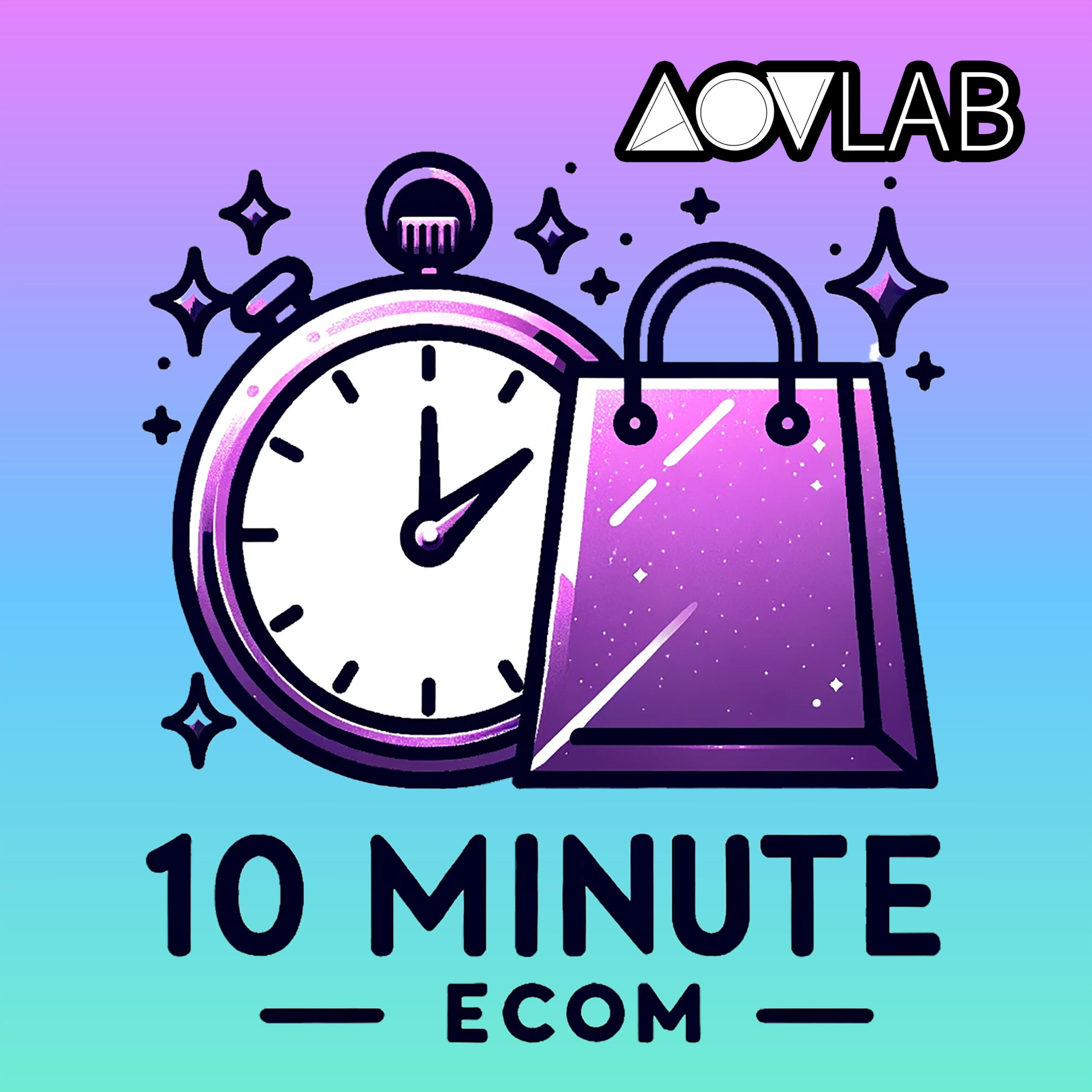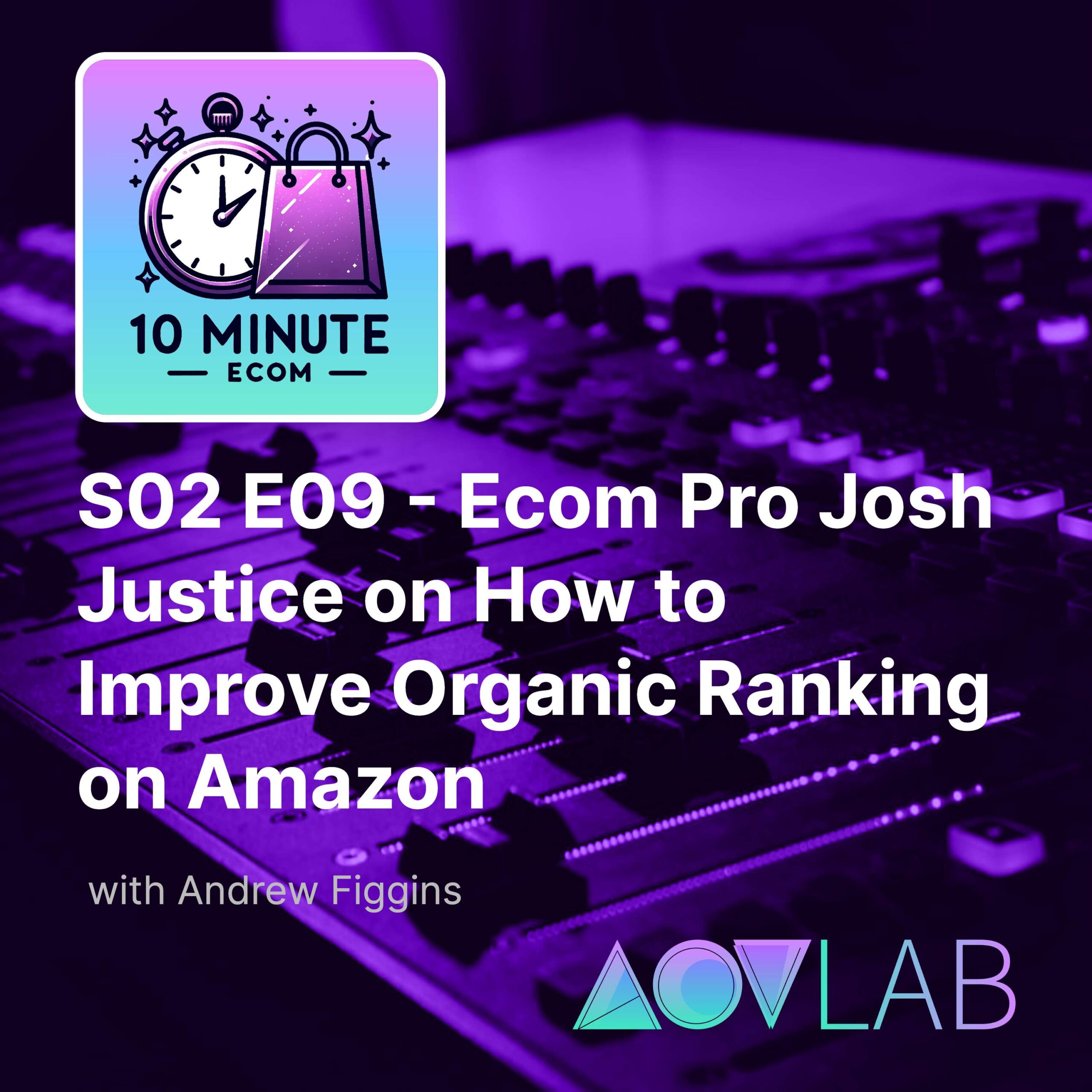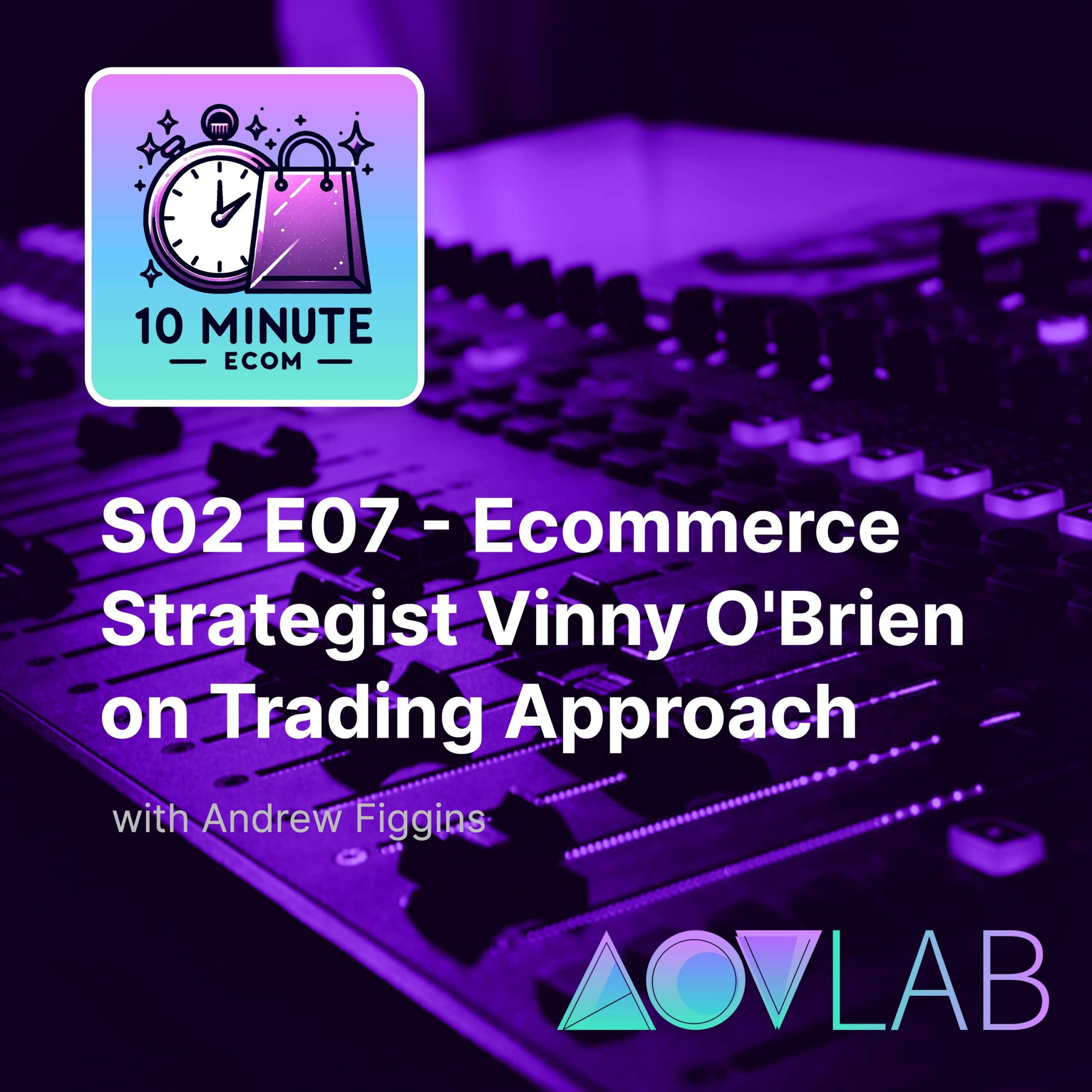View Full Transcript
Episode Transcript
[00:00:07] Speaker A: Hello ecommerce fans, and welcome to ten minute Ecom and AOV Lab podcast. Every episode we break down a new and different tactic that can help you improve your ecommerce KPIs key performance indicators I'm your host Andrew Figgins. I am an ecommerce professional. You may know me as the founder of AOV Lab. Webb, the former vp of product innovation at Scrubs and beyond, or is the former director of ecommerce technology at Rural King.
Today I'm excited to be talking to Paul Drexler, an ecommerce colleague that is doing very interesting work in ecommerce. We had a nice conversation and it does push about 25 26 minutes. So just some fair warning that really stretching the bounds of ten minute ecom today.
[00:00:50] Speaker B: But very excited to have Paul on.
[00:00:52] Speaker A: He is an expert at affiliate Commerce and anyway, let's get right to it.
[00:00:57] Speaker B: Paul, what did you come on the.
[00:00:58] Speaker A: Show to share today with your e commerce colleagues?
[00:01:01] Speaker C: Hi, I'm Paul Drexler and I'm with Shopa Freak's e commerce newsletter based out of Asheville, North Carolina, currently talking to you from Cuenca, Ecuador.
One thing that I've seen that works in ecommerce is affiliate marketing. It's a win win channel that I highly believe brands in 2024 need to engage with. Thank you, Paul.
[00:01:21] Speaker A: After the ad, we'll get right into the chat. Today's episode of Ten Minute Ecom is brought to you by shop AOV Lab. It is a brand new store with fun apparel and gear specifically for Ecom professionals just like you and me. We've got high quality embroidered and printed t shirts, hoodies and hats that will spice up any Zoom call or in person meeting with your team. If you lead a team, these products make for awesome gifts to celebrate hitting a conversion rate or average order value milestone. If you work in ecommerce, I think you'll not only find some humor in these products, but also a sense of.
[00:01:59] Speaker B: Pride for what you do every day.
[00:02:01] Speaker A: Again, the site is Shop AoV lablab.com. Head over right now and browse while you listen. Unless you're driving.
[00:02:09] Speaker B: In that case, pull over.
[00:02:11] Speaker A: You've got to see and share these products one last time.
[00:02:15] Speaker B: The website is shop aov lablab.com.
And now back to the show.
Excellent, Paul, and I'm so excited that you're here today on ten minute ecom. It was a pleasure meeting you before we had a chance to start the recording today. And I like that you're bringing an approach to talking about affiliate marketing that's a little bit different than what we've had on the show before. This is a show for ecommerce operators and typically there's a little bit of advice given, but you're taking sort of an opposite tactic in that you're talking about what not to do in affiliate marketing today.
[00:02:51] Speaker C: Definitely. And just to give you a brief background about why it even matters, what I'm saying, I hugely believe in affiliate marketing. I think it's a win win for everybody involved. And I have personally helped set up affiliate programs and structure affiliate programs for hundreds of DTC brands in the past decade. On the other side of the coin, I am an affiliate for hundreds of brands myself through my travel company. And on the third side of the coin, if that exists, I always launch affiliate programs for all of my own brands. So I've seen the industry from three different perspectives and I feel like I have a lot to offer. Talking about it today.
[00:03:29] Speaker B: Excellent, Paul. Let's get right into it. I think you brought a set of nine things to basically avoid if you are a brand or an e commerce professional, that's either doing affiliate marketing or looking into it. I know just speaking for myself and being a d to c operator, affiliate marketing has stood out as an opportunity. But I know I've made a couple of little attempts to do it that really haven't worked. So I'm looking forward to hearing a little bit more today from your experience.
[00:03:59] Speaker C: Yeah, it can be a great channel. It can be a company's number one source of revenue, but it's definitely not an outsource it, set it and forget it channel. It's definitely something you have to put a lot of grind work into, especially at the beginning. So what I'll do, I've got nine mistakes that folks make when they're launching their ecommerce, I'm sorry, their affiliate programs. And so I know you try to keep this at about ten minutes. I'll keep it about 30 seconds apiece and I'd love to hear your opinion on each one. Or we can move on to the next.
[00:04:26] Speaker B: Excellent. Yeah. Ten minutes in air quotes a little bit. So if we go a little bit longer, that's AOK.
[00:04:31] Speaker C: Got you. So the number one, and I'm going to start big and narrow down as we get to it. But the first mistake is just having the wrong mindset when it comes to launching their program. And what I mean by that is companies that have never launched an affiliate program before, they tend to look at it at another kind of channel that they run ads on. So, for example, oh, it's like running Google Ads. It's like running Facebook ads. So they tend to look at it in terms of ROI and say, how do I launch an affiliate program that makes our business as much money as possible? It's all about the ROI and they're looking at it very mathematically. And I say this is a mistake because when the focus of the affiliate program is actually on you, the company, then you're already off to a wrong start. The right mindset to have when you're launching an affiliate program is how do I create a program that'll make my affiliates as much money as possible? How do I make my affiliates as successful as possible with our program? How do we structure our compensation packages? How do we provide resources, tools, training, all the above so that our affiliates will love our program, make a ton of money and stick with it. Obviously you have to think about ROI and your costs, but that should really be secondary. If you can't create a program that makes your affiliates as much money as possible, affiliate programs might not be the.
[00:05:51] Speaker B: Right fit for your company.
That makes a lot of sense. I think having that sort of outside in mentality is good for other aspects in ecommerce makes a lot of sense for affiliate marketing too.
[00:06:03] Speaker C: Leading into number two with that mindset, I see a big mistake folks make is number two, they compete against their affiliates. And so a great example of that is they'll give each one of their affiliates like a 10% discount code, a branded code, to go and advertise their social media. Then after the affiliate drives the traffic to their site, then the website says sign up for 15% off. So basically the company is offering a better discount than the affiliate has. So the affiliate is losing out on the deal. And again, you want to set your affiliates up for success so that they can make as much money as possible. And if your customer gets to that bit, because a cookie is one thing, you can track affiliate sales via links or via discount codes, but especially coming from social media like Instagram where they don't have a lot of links, a lot of times they're just going with a branded discount code. Well, if I don't use that branded discount code because I use my better discount code from the company itself, affiliate lost out and you're not going to have affiliates for very long.
[00:07:02] Speaker B: Excellent. I wonder, do you advocate if an affiliate link is being tapped on or clicked and someone's arriving on the site to very purposely turn off those kind of pop up messages that might introduce some kind of promotion?
[00:07:17] Speaker C: You can certainly do that? Yeah. The other thing is just having a discount code that is commensurate with another one. But it's a deeper conversation because it has to do with the company's discounting strategy altogether. You have to really look at it from a top down approach. I've had worked on some brands before where we just notoriously don't offer discounts. We don't employ discount codes. We'll put items on sale throughout the year for various promotions. But we reserved our discount codes specifically for the affiliates so that we wouldn't compete against them. And I don't mean to say that's right for every company, but it's important just to look at all your discounting that you do through every channel and then think about how does that compete or support our affiliates and the discounts that we're offering them as well.
[00:08:04] Speaker B: That makes a lot of sense.
[00:08:05] Speaker C: One other example, just on that note, like maybe you offer 15% off on your website, but free shipping launches at $250. If your website can allow for multiple discount codes, you could certainly allow all sales, no matter what price point that come through an affiliate, to qualify for free shipping. Just one example of two non competing discounts or promotions working side by side, one from the affiliate, one for the company. But there's certainly a limited number of accommodations.
[00:08:33] Speaker B: Absolutely makes sense to look at it holistically as well, and not just one discount for one group at a time. I think that makes total sense.
[00:08:42] Speaker C: Third one I've got for you today is, and I'm going to touch on outreach because obviously you can create a very attractive program. You can have an awesome affiliate program, high commissions, very attractive, but you still need the affiliates. And so the next step becomes outreach to those affiliates. I firmly believe that your best affiliates are always going to come from one on one, personal outreach. And it's a two way street. So some of your best affiliates might come from the fact that they already have a relationship with your company as a customer and they reach out to you, or on the opposite side of the coin, you go and find the affiliates who have the audience that's the best fit for your company. So this has to do with outreach. I see a lot of companies just completely speak the wrong language when they're doing outreach to affiliates. So one example is they'll use a term like sign up to our affiliate program and earn extra cash. And if this isn't a hobby for us, I make a living from affiliate marketing. I need revenue, I need income, not extra cash. If you want to talk about extra cash. Maybe the program is a better fit for a customer referral program where every customer can refer their friends. And at that point it's not even extra cash. You're giving away credit. So there's really never, in my opinion, a room to talk about earning extra cash or treating affiliate marketing as a hobby. Because at this point you don't want hobby affiliate marketers, you want professional affiliate marketers, you want professional influencers. So you've got to speak in the language that resonates with the people that you're reaching out to, which is, hey, we respect what you do and we respect what you do so much that we're going to offer you forms of revenue, offer you forms of income, not some side hustle. Earn an extra $50. That's not going to tip the needle for the kind of affiliates that most companies want, 100%.
[00:10:30] Speaker B: I think it makes a lot of sense to look at it like your affiliates are business people. They're not hobbyists in many case, and you want them to be business people because I think as you're indicating, the higher dollar amounts that they're bringing in for you, the higher amounts they're earning as well. And it's like you said before, it's a triple win for all involved.
[00:10:49] Speaker C: Absolutely. Next one I've got for you is I love this one. I think this is one of the most underutilized strategies in affiliate marketing. So the mistake is thinking that the handoff is finished when the visitor clicks from the influencer website or blog over to the website.
And the reason I say that is because some products have a longer educational cycle and they require multiple touch points, sometimes from the affiliate and sometimes from the company itself too. So to think that all we need from this affiliate is just one handoff and then we take it from there, that doesn't always work. Some of the most successful programs I've seen. Now you can't do this for every affiliate, the small one. But for the larger affiliates, they'll actually continue the conversation from the affiliate's website over to the company's website.
So there was one oral healthcare website, their top affiliate. Not only was she like 80% of their affiliate program, but at some point she became most of their revenue in general, like this one mommy blogger was bringing this startup company about $4 million a year just from her blog and social presence. So when you went from her website to the oral healthcare website, that wasn't it. You actually landed on a landing page that had her face, that greeted readers from her publication and continued the conversation showcasing some of her products. And these are products that you had seen on her blog, where she had talked about it in multiple places, on her social media, on her blog post. So my point just being that the handoff isn't done, it's not. Send us the link, we'll take it from there. You really want to engage your affiliates to be as big a part of your company as you'll allow. One recent example, and this isn't even affiliate, this is just through a sponsorship with Shopify Freaks. I'm onboarding a few news partners. So one of the news partners, estreamly, they do live streaming. When you go from my newsletter and you click over to learn more about estreamly, it takes you to a landing page, prompts you to sign up for their newsletter, get their free report, but then you see my face, my logo from shopper freaks with me talking about how, and this is true, I wouldn't say it otherwise, how I believe that live shopping is coming to the west in a big way. And so the whole point of having me there in that quote is just to continue the conversation from one site to another. I think more brands need to take advantage of that.
[00:13:10] Speaker B: Yeah, it's really a continuation of that trust factor. And sometimes you never know if you tap a link or click a link.
[00:13:17] Speaker C: Where you're going to land.
[00:13:18] Speaker B: But I love the idea of it being that continuation, that continuity.
It's not just a tap on an affiliate link, but really it allows you to continue to tell that story as an affiliate. You can continue that conversation with the customer, and obviously it's working. I think many of our listeners, if they heard the possibility or knew the possibility that they could drive an additional $4 million a year in revenue, they'd be pretty excited.
[00:13:44] Speaker C: Now, those are the power affiliates and certainly the ones you want, but you don't always know the ones you're going to get when you sign them up. If you could just go after those affiliates, you would. But sometimes it's the ones that surprise you that end up doing that. But all said and done, I think if you have an affiliate program, some companies just haven't thought of ways that they can leverage their affiliates outside of getting traffic. And hopefully if you hear this, you'll say, hey, wait a minute, these are our partners. Maybe we should bring them into our ecosystem as much as they're bringing us into theirs. On the note of treating affiliates as the partners that they are, I wanted to say, number five, the mistake I see is not training affiliates on the best way to sell your products. Or alternatively, companies not learning from their best affiliates because sometimes your affiliates are better at selling your own product than you and so there's a lot you can learn from it. But on the first side of the coin, I said not training them. What I see happen a lot is a company will onboard affiliates. They'll give them a link, they'll give them a referral and expect the affiliate to take it from there. So the affiliate will make one social post, not make any money from it, or make a little bit of money and say, hey, this isn't working for us. This isn't converting. I'm going to move on to the next campaign, the next promotion. It's bad for the creator because it ends up, hey, this creator is always constantly throwing new stuff in our face and it's bad for the company because they're losing the affiliate. What ideally the company should do is show examples. Hey, creator, we've seen that the best way to promote our product is over the course of 30 days. Frequency and repetition of showing off our product really goes a long way with your audience and getting them familiar with what we offer. So we recommend four stories, six posts, whatever fits the brand. But showing them examples, if they have them, of what other creators have done and walking them through that step by step too, to set them up for success.
[00:15:36] Speaker B: Yeah. B to C brands are certainly familiar with the idea of social proof, but I like this idea of provide the social proof to your affiliates and your partners. Show them, maybe here are the posts that have been most effective. And as you said, here's the cadence that works.
[00:15:51] Speaker C: And I covered this in number five, so I'll gloss over number six briefly. But number six was just, the mistake is not setting realistic expectations with affiliates. They come out with the outreach and they say, look what our top affiliates are making. And you're like, oh, wow, I want to make $2,000 a month of recurring income. But what they don't necessarily show is what that other affiliate was doing to get there. And so part of that is through the training and the conversations and really setting your affiliates up for success so that they know, yes, you can make this, but here's the steps you could take or work from to make that happen.
[00:16:27] Speaker B: Excellent. Paul and I know we have three tips left or mistakes left to go through. So I'm excited. I'm just going to keep giving you the floor, man. You're bringing the knowledge. Appreciate it.
[00:16:38] Speaker C: Sounds good. Okay, so number seven, mistake is just not having your contracts and your brand guidelines set up from day one and really enforcing them from day one. And so basically what I'm saying is letting your affiliates know what they should do and encouraging it, but also letting them know what they shouldn't do. And I'll just give you two, three quick examples. One is a lot of companies, they do not want you posting your affiliate discount code and sending it to retailmenot or those discount code aggregators. It's not in the spirit of why they're offering that discount code. Now as an affiliate, I've got to admit I've done that countless times. If a brand doesn't tell me not to do it, I'm definitely going to do it. And that adds to my bottom line. Do I have anything to do with generating that sale? No, not really, but I'm making the commission. So most affiliates, like myself, are going to do what it takes within the rules of the program to make as much money as we possibly can it. So if that's something you don't want your affiliates to do, then you should educate them about that from the very beginning. You can't always help it. Sometimes discount codes leak and they ended up on there whether the creator does it or not. But another thing, I'm big into pay per click ads, especially with Google. So you probably don't want your affiliates competing against you on Google. So if you take your brand name, a lot of companies will do their brand ads where they show up when someone searches their name. You don't necessarily want me or another affiliate doing that as well and offering my discount code because now we're both potentially, imagine 100 people doing this. Now we're boosting the price of the auction and making it more expensive for the brand. So you want to prevent that from the very beginning. List goes on and on. Spamming Message board, Spamming Reddit. You really want to make sure that your affiliates are promoting you in a way that's authentic to your brand and not putting you in a position where these are your brand ambassadors. So you don't want them going out there and spamming Message boards because that makes you look like a spammer company.
[00:18:28] Speaker B: Make a lot of sense.
[00:18:30] Speaker C: I like this one. This is NUmBer eight. This is a mistake I see happen when companies are setting up their affiliate ProgrAm from day one, like creating the structure around their commissions.
The mistake is they don't account for what I call the perfect storm. And an example of that is it's the Holiday Season. We just marked all of our products 20% off on the website. New customers get 15% off. We offer free shipping above $99. So suddenly someone's spending $101 and they get FREe Shipping. They get 20% or $120. We'll say they hit the $100 tier, they get the Free Shipping, then they get the 15% off. The List goes on and on. You have to make on top of that, are they paying an 8% commission to an affiliate? So I like to start with spreadsheets that don't just take into consideration the discount that I'm offering affiliates if I offer one, but it also takes into consideration all the other pricing strategies and discount strategies and promotions that we do throughout the year. You can't always account for all of them because obviously a company is going to experiment with new things in the future. But for the most part, most brands have a good idea of their promotional strategies and how they at least structure them. So you need to make sure that you can offer a commission. And on that note, with the perfect storm, you got to communicate your commissions. And I see a lot of companies start way too high and then not leave any room for error or not leave any room for anything else. A good example is just because you can afford to offer 15% commission doesn't necessarily mean that you should or that you have to. If competitors in your space are offering five to 7%, you could offer eight or nine and still be the most attractive person who offer company that offers that commission. But it also leaves room for you to incentivize your power affiliates more. For example, if you start a little bit lower than you think you need to, you account for the extra commission in your pricing model that you could offer your power affiliates. If you got an affiliate bringing in a million dollars a year, you can certainly up them to 15% to get them to bring in 2 million a year. So that's one mistake I see too. It's just not accounting for all the different discountings and commissions that could come up in the future.
[00:20:47] Speaker B: I love the idea of having those extra sweeteners for those power affiliates, obviously, and love the example you just shared. If you can get an affiliate to go from million dollars to a million dollars, obviously you're in a much better place.
[00:20:58] Speaker C: You can up their rate. Because I've had companies do this to me a lot of times over the years. They see the traffic that I'm driving to them. They give me a higher rate or I'll sometimes negotiate that higher rate. Companies have to be ready for that expectation as well too. If I'm bringing in, there was one company I brought in I remember this is 2018 $580,000 worth of sales. This one company that was starting to be a percentage of their sales. And so obviously I hit about myself and I was like, hey guys, I want to, one, get a better discount for my audience, but two, get a better commission for myself. So just when you think about your perfect storm, you have to be prepared for those scenarios that are inevitably coming with your power of billions and math.
[00:21:35] Speaker B: I think backing up all of it with the spreadsheet that you mentioned too.
[00:21:38] Speaker C: And it's okay to break even too. In a worst case scenario, it's okay to lose a little bit of money too, depending on the lifetime value of your customer. So it's not a matter of not doing that, it's just a matter of being aware of it and doing it strategically. Last one I've got for you today, and I love this one. This is one of my favorites too. It's not promoting your affiliates. I've seen a lot of companies get better about this as user generated content has been all the rage in the past few years. But I like to say that running an affiliate program is a two way street. And so if your mindset is correct that we're going to help our affiliates make as much money as humanly possible, then it goes without saying that you should promote their efforts. If an affiliate puts out some great content, share that content through your own network and use the affiliate link. Imagine affiliate getting a boost of sales because you sent a newsletter out to your audience showing their video, their photos and then using their link. This is the kind of goodwill you want to create towards affiliates. But also, like I said, in the era of user generated content, it's almost mandatory at this point that you leverage the content your affiliates are creating but incentivize them through continuing their commissions. I've seen a lot of companies in the past, just like I said, they look at affiliate marketing as the same as their other channels. This is just like Google Ads. So we compartmentalize everything that we do. But affiliate marketing is very different. It doesn't need to be compartmentalized, outsourced to an agency. It needs to be part of so many other facets of your business, your content creation, other types of marketing that you do, image videos, like every social media. It can if you allow it to play a much larger role. But what they're turned off about is the fact that allowing it to play a much larger role, they look at it as sending commissions out the door, but it's short sighted. It can do a lot more. Once you have that customer, they're your customer. And so it's short sighted. If you're going to give Amazon 15% or up to 40% with ads, then why wouldn't you give your affiliate 10% or whatever it is as many times as humanly possible to get that customer email to bring them into your ecosystem. And then you send out your newsletters and your promotions and you continue to make money from there. So for me, again, it's all about making affiliates as much money as possible. Just go full circle here and then you'll have a successful program.
[00:23:54] Speaker B: Yeah, a very valid point about just that percentage that can be handed off essentially to a marketplace like Amazon. It's growing and growing. I think there's been increases even recently at the start of this year. So love the example. And Paul, you shared the nine mistakes today, but I feel like I have nine more ways to improve my own affiliate marketing based on your expertise today. Thanks so much for coming on ten minute EcoM today. It is a brief show. I wanted to ask you though, before we head off, is there anything else that you'd like to share with your colleagues out there who are in e commerce?
[00:24:30] Speaker C: Just stay on top of what's going on. Again, not to promote myself too hard, but I run a great newsletter at shopper freaks. It's not at all strategy like you're doing. Your publication and your podcast is all about strategy. It's super valuable. My newsletter doesn't tell people what to do. It just keeps up with what's happening in major companies. And I think that a lot of feedback I've gotten from readers is just that by keeping up with what big players are doing, by keeping up with new partnerships and integrations, it gives them insight into how they should structure their strategy for the following year. So that's my advice. Just keep up because things are changing quicker than ever.
[00:25:05] Speaker B: Paul, thanks so much again for coming on. I really appreciate you being here and just speaking on behalf of people listening. Thank you for sharing this knowledge today. Really impressive.
[00:25:15] Speaker C: Thanks for having me.
[00:25:17] Speaker B: We have hit that ten minute mark, so that's a wrap for today's episode.
[00:25:21] Speaker A: I want to again thank our guest, Paul Drexler.
[00:25:24] Speaker B: If you have a moment, be sure.
[00:25:26] Speaker A: To subscribe or follow the show on Apple Podcasts, Spotify, Amazon Music, Google Podcasts, or wherever it is that you listen.
As mentioned earlier in the episode, please head on over to shop AOV Lab, our brand new store that helps to support this podcast. It is launching with nearly 100 products, so plenty to choose from our top.
[00:25:50] Speaker B: Seller so far is a shirt that.
[00:25:51] Speaker A: Simply says ECom on it. I wear it around my extended family so I can point to it when my relatives ask me what I do.
I hope you enjoyed this episode of the show. Until next time, this is Andrew Figgins signing off and saying have a good one.
